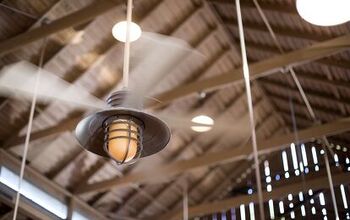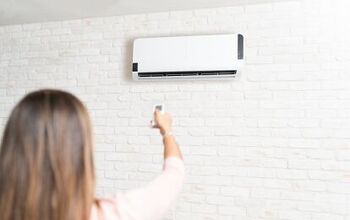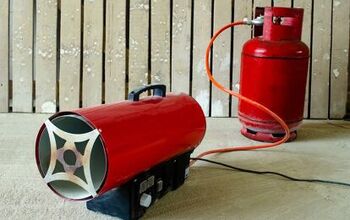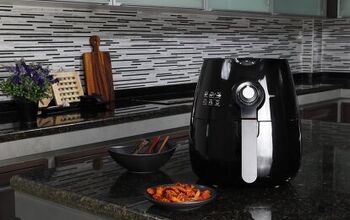Can You Put A Gun Safe In A Garage? (Find Out Now!)

Whether you have guns for hunting, sport, or home protection, where you store the firearms is an important decision. A gun safe is an option, but it needs to be in the right place. You may consider installing the safe in your garage, but is this a good idea?
You can put a gun safe in the garage. Maintain a temperature of 70° F and humidity of 50% or less. Secure the safe to the concrete. Install it away from doors and windows. Store flammable substances away from the gun safe.
Let’s take a closer look at gun safes and best practices for where to install them. We will then discuss the idea of putting a gun safe in your garage.
What is a Gun Safe?
A gun safe is a locking cabinet that is designed specifically for firearms and ammunition. The purpose of the safe is to keep your guns where others cannot get to them. Gun safes are also designed to withstand fires, floods, and other disasters that will damage the firearms and ammunition.
Gun Safe vs. Other Types of Safes
Guns safes and other types of safes have many similarities. Any type of safe has a locking mechanism and a design that protects against theft and damage from fires, floods, and other natural disasters. The key difference between a gun safe and regular document safe is the configuration of the compartment. A gun safe has shelves, drawers, and stands that are made to hold firearms, such as pistols, rifles, and shotguns. The safes also have special compartments for ammunition.
Types of Gun Safes
There are 2 types of gun safes. The first is a lock box that you can keep in a closet or other enclosed area. The safe is small enough to move around as needed. Lock box gun safes are best for one or two handguns and ammunition.
The second type of gun safe is a large, secured cabinet. These are best for homes with a collection of handguns and long guns, as well as ammunition, scopes, gunpowder, and other items. Gun safes of this type may be set on the floor or secured to a concrete slab with bolts.
Do I Need a Gun Safe?
If you only have a few handguns, a regular safe will work for your needs. Just make sure that the safe is large enough. It should have room for the firearms and ammunition, as well as other personal items that you want to protect. The safe should have a heavy-duty locking mechanism and a mechanical or electronic combination lock.
Combination locks are preferred. Keys for safes get misplaced and stolen. Another type of lock to consider is a biometric lock. This requires a match to your fingerprint, voice, or face.
Is It Safe to Store Your Guns in a Garage?
If you are looking to purchase a floor-style gun safe for your home, you can put it anywhere that fits the exterior measurements of the unit. Securing a gun safe to a concrete slab provides an extra layer of protection against theft. The safe needs to be on the lowest level of your home, whether it’s the main floor, basement, or garage.
Pros of a Gun Safe in Your Garage
The primary benefit of installing a gun safe in your garage is that it is out of the way. If you are short on space or concerned about having guns inside your home, the garage is worth considering. Understand, though, that the disadvantages of putting a gun safe in the garage outweigh the advantages.
Cons of a Gun Safe in Your Garage
Here are some disadvantages to consider before putting your gun safe in the garage.
- High humidity that may damage the firearms and ammunition
- Higher risk of fire due to flammable substances that are stored in garages
- Difficult to access to the firearms in an emergency
- Higher risk of theft
Can You Put a Gun Safe in an Unheated Garage?
You can put a gun safe in an unheated garage, but you’ll need to control the climate. Ideally, the inside of your garage should be around 70° F with no more than 50% humidity. A dehumidifier removes excess moisture from the air. Also install a gauge that measures humidity levels and place packets of gel desiccant inside the safe.
Can You Put a Gun Safe in a Garage with Humidity?
Humidity creates corrosion on your firearms, and this affects performance. Maintain a humidity level of 50% or less inside your garage. A humidity gauge inside the gun safe is always a good idea. Check your guns regularly for signs of excess moisture and corrosion.
Tips for Storing a Gun Safe in a Garage
If your garage is the only place where you can store your gun safe, here are some best practices to keep in mind.
Build a Cabinet
Build a cabinet for your gun safe in the garage. The idea is to conceal the safe and prevent theft. Try to make the cabinet look like a normal part of the workspace in your garage.
Keep the Safe Away from Doors and Windows
Install your gun safe away from doors and windows in the garage. These are easy access points for thieves. People are less likely to attempt a robbery if they have to go further onto the property
Store Flammable Substances Away from the Safe
Keep any and all flammable substances far away from your gun safe. If a fire breaks out, you don’t need the combination of ammunition and flammable substances. Even better, store the substances in a shed in the backyard.
Secure the Gun Safe to the Concrete
Thieves are very clever when they want something. They will wrap a chain around a gun safe and drag it away from the home. Once in a safe and secluded location, they set to work at cracking open the safe. Securing your gun safe to the concrete in your garage acts as a deterrent. Thieves like easy jobs, and they will walk away from any opportunity that is too risky.
Related Questions
Where is the best place to put a safe in your house?
The best place to put a safe in your house is a corner where two outside walls meet. For homes with more than one level, the best place for a safe is on the lowest level of the home.
Conclusion
Although not ideal, you can put a gun safe in your garage. Take steps to manage the humidity and risks for fire and theft.
Related Guide

Jennifer L. Eggerton loves being hands-on, whether it's with a home DIY project, making repairs, re-decorating a room, or keeping life organized. She enjoys helping people by sharing her knowledge, insights, and experiences, as well as her lessons learned. In addition to her work as a writer, Jennifer is a Jeep® overlander, self-published author, and nature photographer who loves being outdoors.
More by Jennifer Eggerton



























